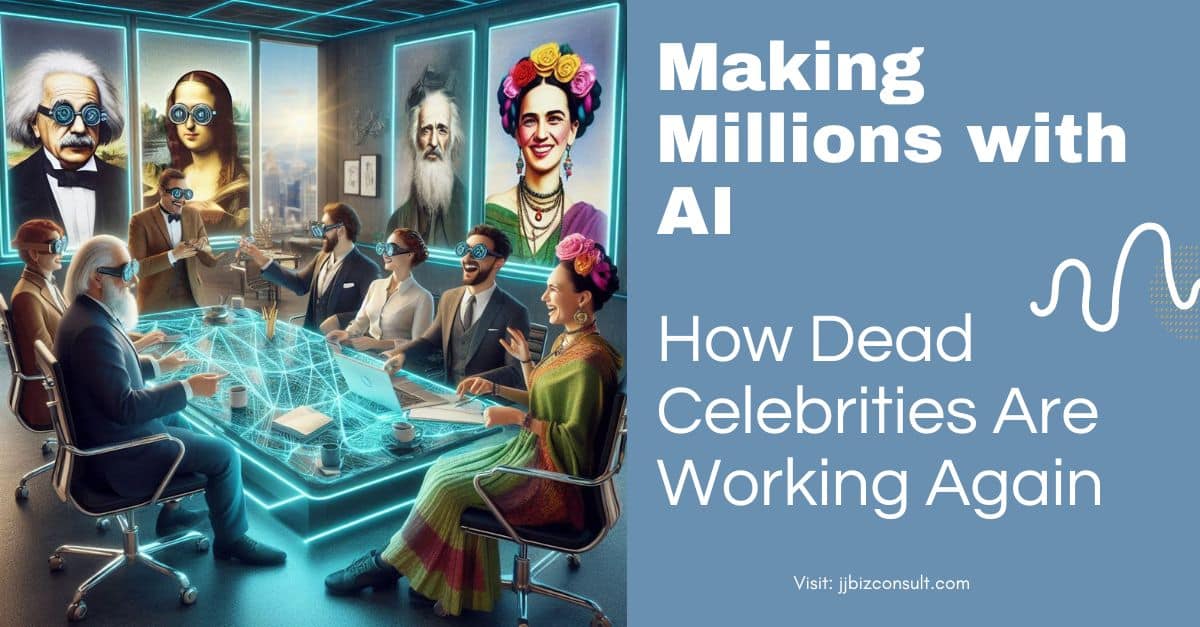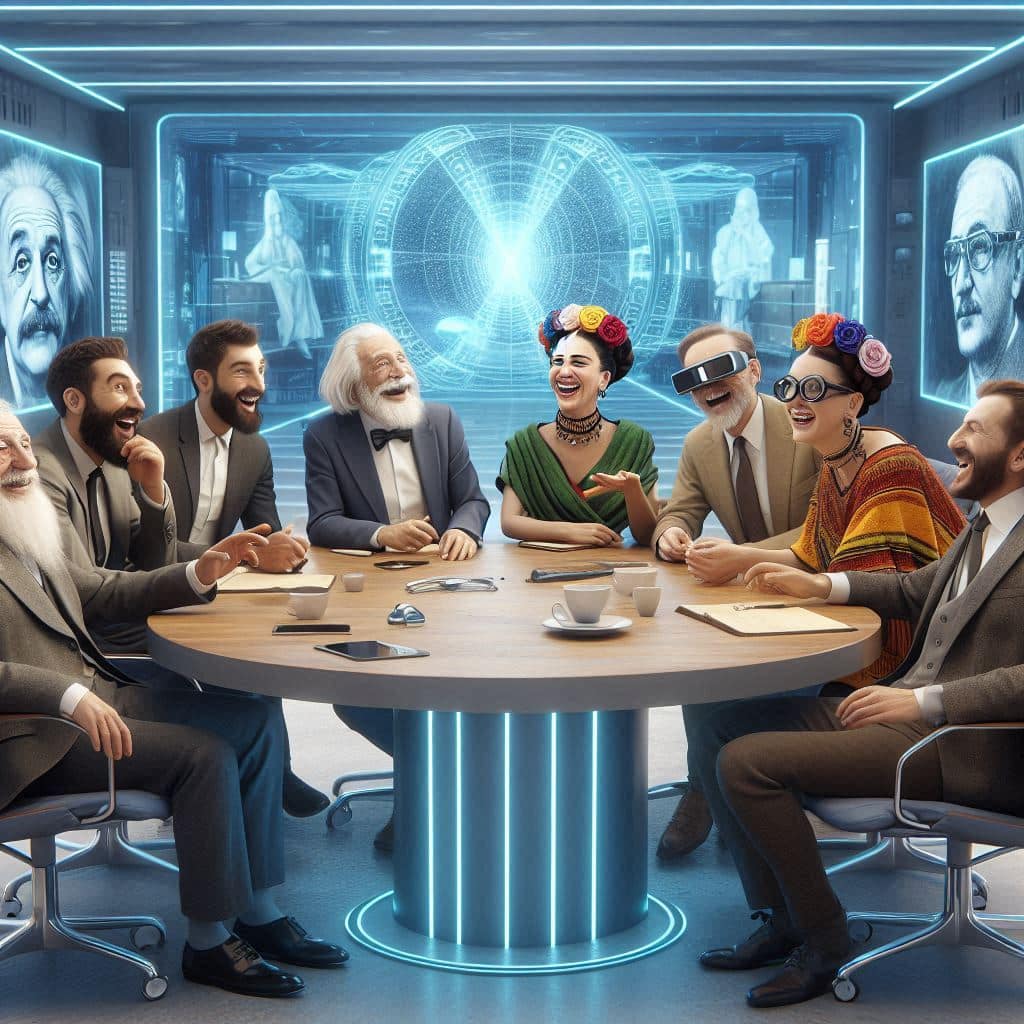
Making Millions with AI How Dead Celebrities Are Working Again
In the age of artificial intelligence, the boundaries of reality and fiction are increasingly blurred. One of the most fascinating and controversial developments is the resurrection of dead celebrities through AI technology. This phenomenon is not only captivating audiences but also generating substantial revenue. Let’s delve into how AI is bringing deceased icons back to life and the implications of this digital resurrection.
The Rise of AI in Entertainment
Artificial intelligence is transforming the entertainment industry in numerous ways, from content creation to audience engagement. Here are some key aspects of this revolution:
1. Deepfake Technology
Deepfake technology is this crazy thing that uses AI to make super realistic digital lookalikes of people. It’s like, you can take a celebrity who’s no longer with us and pop them into new movies, commercials, and even live shows like they’re actually there. It’s been used to bring back stars, like James Dean, for fresh film projects. It’s wild, right? They look and seem so real, it’s like they never left the screen.
2. Voice Cloning
Voice cloning? It’s like having a copycat for voices, but not the annoying kind you’d find on a karaoke night. This cool tech uses AI to make a person’s voice sound just like the real deal. You know, like when you’re listening to something and you’re like, “Wait, is that really them?” That’s companies like ElevenLabs doing their magic. They’re like the rockstars of the voice world, making AI voices for stuff like audiobooks or those commercials that you actually pay attention to. And the kicker? It can keep your favorite celeb’s voice around, even when they’re not. So, if you’re missing their sweet tones in new projects, don’t worry, their voice lives on. Ain’t that something?
3. Digital Avatars
Digital avatars, man, they’re like those cool AI-made twins of people that pop up in all sorts of digital stuff. Companies like WorldwideXR, they’re the wizards behind these bad boys. They whip ’em up for movies, VR hangouts, and a bunch of other wild experiences. It’s like having a buddy from the future that you can chat with or watch flicks with, except it’s all pretend and computer-y. They can do stuff with you that no real person could pull off, like teleporting into your favorite game or giving a speech in a full-on 3D hologram. Crazy, right?
4. Content Creation
AI is getting pretty good at whipping up new stuff, you know? Like, it can totally come up with scripts, jam out some music, and throw together whole scenes for our fave movies and TV shows. It’s crazy how it speeds up the whole making-stuff-happen deal. Plus, it’s like having a creative twin for big-shot artists, so they can keep doing their thing even if they’re not around to do it themselves. It’s like having a never-ending supply of fresh ideas on tap, and that’s pretty cool.
5. Audience Engagement
AI helps make sure the stuff you watch or listen to is tailored just for you, which is pretty cool. It looks at what you’ve liked before and what you usually do, and then it suggests movies, TV shows, and songs that it thinks you’ll totally dig. This makes it way easier to find something to enjoy, and it keeps you hooked for longer because everything feels like it’s handpicked. It’s like having a buddy who knows exactly what you’re into and always has the perfect recommendation up their sleeve.
Iconic Voices and Digital Clones
Imagine hearing that cool dude James Dean reading you a story, right? Or watching him in a brand new flick? Believe it or not, it’s actually gonna happen. The folks who look after the legacies of stars like James Dean, Judy Garland, and Burt Reynolds have made some pretty wild deals with AI companies. These companies are gonna use their voices and faces in new stuff they make. So, James Dean’s going to be in this upcoming film, “Back to Eden,” and it’s all thanks to some fancy AI tech. Crazy, huh? It’s like they’re bringing these legends back to life on screen.

Financial Windfall
The financial upside of bringing back dead celebs is just crazy huge. These digital look-alikes can rake in millions from all sorts of places, like the big screen, ads, and even doing live shows. Take Whitney Houston’s hologram, for instance. It had a full-on six-month gig in Vegas, packing the house and making some serious dough. And get this, AI-made voices are popping up in commercials, audiobooks, and more, creating all these fresh cash flows for the celebs’ families and whoever’s looking after their stuff.
So, let’s chat about this wild idea of bringing back stars using AI and digital tricks. Here are some cool things to think about:
Financial Opportunities
- Movies and TV Shows: Digital clones of deceased celebrities can star in new films and TV shows. For instance, James Dean is set to appear in a new movie called “Back to Eden”.
- Advertisements: AI-generated versions of celebrities can be used in commercials. Brazilian singer Elis Regina was recently brought back to life for a car advertisement.
- Live Performances: Holograms of celebrities like Whitney Houston have performed live, drawing large audiences and generating substantial revenue.
- Voice Work: AI-generated voices of deceased celebrities are being used in commercials, audiobooks, and other media, creating new income streams for their estates.
Ethical Considerations
While the technology is impressive, it raises several ethical questions. Who owns the rights to a deceased person’s likeness and voice? How should the profits be distributed? There are also concerns about consent and the potential misuse of AI to create misleading or harmful content. These issues are prompting ongoing debates and legal discussions about the future of AI in entertainment.
The Future of AI and Dead Celebrities
As AI technology continues to advance, the possibilities for resurrecting dead celebrities will expand. We may see more iconic figures returning to the screen, performing in concerts, or even interacting with fans in virtual reality. However, it is crucial to navigate the ethical and legal challenges to ensure that this technology is used responsibly.
In conclusion, the resurrection of dead celebrities through AI is a fascinating blend of technology and nostalgia. It offers new opportunities for entertainment and revenue but also requires careful consideration of ethical and legal implications. As we move forward, striking a balance between innovation and respect for the legacy of these icons will be key.
How can we address the ethical concerns around this technology?

Addressing the ethical concerns around the use of AI to resurrect dead celebrities involves several key steps:
1. Clear Consent and Rights Management
- Pre-Death Agreements: Celebrities can specify how their likeness and voice can be used posthumously through legal agreements.
- Estate Permissions: Ensure that the estates or legal representatives of deceased celebrities have clear rights and give explicit consent for any AI-generated content.
2. Transparent Usage Policies
- Disclosure: Clearly inform audiences when AI-generated content is being used. Transparency helps maintain trust and prevents misleading the public.
- Purpose Limitation: Define and limit the purposes for which AI-generated likenesses can be used, avoiding contexts that could harm the celebrity’s legacy.
3. Ethical Guidelines and Regulations
- Industry Standards: Develop and adhere to industry-wide ethical guidelines for the use of AI in recreating deceased individuals.
- Legal Frameworks: Governments and regulatory bodies should establish laws that protect the rights of deceased individuals and their estates.
4. Revenue Sharing
- Fair Compensation: Ensure that any revenue generated from AI-generated content is fairly distributed to the estates or designated beneficiaries of the deceased celebrities.
- Charitable Contributions: Consider allocating a portion of the profits to charitable causes that the celebrity supported.
5. Public and Stakeholder Engagement
- Feedback Mechanisms: Engage with the public and stakeholders to gather feedback and address concerns about the use of AI in this context.
- Educational Campaigns: Inform the public about the technology, its benefits, and its ethical implications to foster informed discussions.
6. Technological Safeguards
- Content Moderation: Implement robust content moderation to prevent the misuse of AI-generated likenesses in harmful or inappropriate ways.
- Security Measures: Protect the digital assets and data used to create AI-generated content from unauthorized access and misuse.
By taking these steps, we can navigate the ethical complexities of using AI to resurrect dead celebrities, ensuring that the technology is used responsibly and respectfully.
Examples of AI misuse in this Context
There have been several instances where AI technology has been misused to resurrect dead celebrities, raising significant ethical and legal concerns. Here are a few notable examples:
1. Deepfake Videos for Profit
Some unscrupulous operators have created AI-generated videos of deceased celebrities and sold them online. These videos, often lasting just 30 seconds to a minute, are sold for prices ranging from $11 to $83. This commercial exploitation without proper consent or compensation to the estates of the celebrities is a major ethical issue.
2. Unauthorized Digital Clones
In some cases, digital clones of deceased celebrities have been used without proper authorization. For example, there have been instances where AI-generated likenesses of celebrities were used in advertisements or other media without the consent of their estates. This not only violates intellectual property rights but also disrespects the legacy of the deceased.
3. Misleading Content
AI-generated deepfakes can be used to create misleading or false content. For instance, there have been concerns about AI making deceased celebrities “say and do things” they never would have in real life. This can lead to misinformation and damage the reputation of the celebrities.
4. Emotional Manipulation
AI-generated holograms or digital avatars of deceased loved ones have been used in ways that can emotionally manipulate individuals. For example, Kanye West gifted Kim Kardashian a hologram of her late father for her birthday. While intended as a heartfelt gesture, such uses can be emotionally distressing and raise questions about the ethical implications of using AI in this manner.
5. Exploitation in Media
There have been instances where deceased actors were digitally rendered to reprise their roles in movies without clear ethical guidelines. Carrie Fisher’s digital rendering to continue her role as Princess Leia in the “Star Wars” films is one such example. While this can be seen as a tribute, it also raises questions about consent and the creative integrity of using AI in this way.
Addressing these misuses requires robust ethical guidelines, clear legal frameworks, and transparent practices to ensure that AI technology is used responsibly and respectfully.
By exploring the intersection of AI and entertainment, we can appreciate the incredible potential of this technology while remaining mindful of its complexities. What are your thoughts on the digital resurrection of celebrities? Share your views in the comments below!
Pitfalls Of Image Generator AI And Deep Fake Technology
Text to Video Takes Center Stage: OpenAI’s Groundbreaking “Sora” Unveiled





